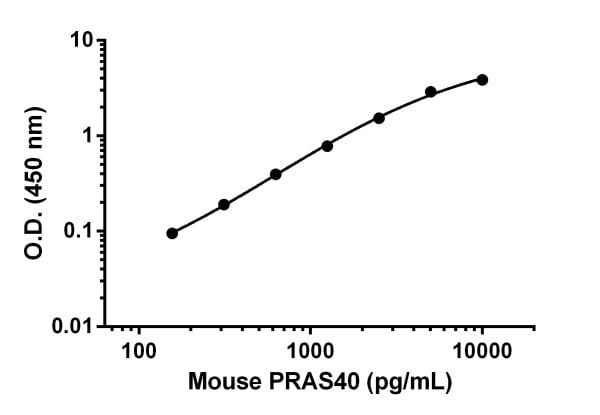Mouse PRAS40 ELISA Kit (ab210580)
Key features and details
- One-wash 90 minute protocol
- Sensitivity: 23.5 pg/ml
- Range: 156 pg/ml - 10000 pg/ml
- Sample type: Cell culture extracts, Tissue Extracts
- Detection method: Colorimetric
- Assay type: Sandwich (quantitative)
- Reacts with: Mouse
Overview
-
Product name
Mouse PRAS40 ELISA Kit
See all PRAS40 kits -
Detection method
Colorimetric -
Precision
Intra-assay Sample n Mean SD CV% Cell extract 5 5.8% Inter-assay Sample n Mean SD CV% Cell extract 3 9.4% -
Sample type
Cell culture extracts, Tissue Extracts -
Assay type
Sandwich (quantitative) -
Sensitivity
23.5 pg/ml -
Range
156 pg/ml - 10000 pg/ml -
Recovery
Sample specific recovery Sample type Average % Range Cell culture extracts 100 96% - 104% -
Assay time
1h 30m -
Assay duration
One step assay -
Species reactivity
Reacts with: Mouse -
Product overview
Mouse PRAS40 ELISA Kit (ab210580) is a single-wash 90 min sandwich ELISA designed for the quantitative measurement of PRAS40 protein in cell culture extracts and tissue extracts. It uses our proprietary SimpleStep ELISA® technology. Quantitate Mouse PRAS40 with 23.5 pg/ml sensitivity.
SimpleStep ELISA® technology employs capture antibodies conjugated to an affinity tag that is recognized by the monoclonal antibody used to coat our SimpleStep ELISA® plates. This approach to sandwich ELISA allows the formation of the antibody-analyte sandwich complex in a single step, significantly reducing assay time. See the SimpleStep ELISA® protocol summary in the image section for further details. Our SimpleStep ELISA® technology provides several benefits:
- Single-wash protocol reduces assay time to 90 minutes or less
- High sensitivity, specificity and reproducibility from superior antibodies
- Fully validated in biological samples
- 96-wells plate breakable into 12 x 8 wells stripsA 384-well SimpleStep ELISA® microplate (ab203359) is available to use as an alternative to the 96-well microplate provided with SimpleStep ELISA® kits.
-
Notes
PRAS40 (also known as Proline-rich AKT1 substrate 1) is a subunit of the mTORC1 (mammalian target of rapamycin complex 1) protein complex which regulates cell growth and survival in response to nutrient and hormone signals. PRAS40 is a direct phosphorylation substrate of AKT and PRAS40 is overexpressed in some cancers. The standard protein in this kit is full length mouse PRAS40 expressed and purified from E.coli. Mouse PRAS40 has 97% and 93% sequence identity to rat and human PRAS40, respectively.
Abcam has not and does not intend to apply for the REACH Authorisation of customers’ uses of products that contain European Authorisation list (Annex XIV) substances.
It is the responsibility of our customers to check the necessity of application of REACH Authorisation, and any other relevant authorisations, for their intended uses. -
Platform
Pre-coated microplate (12 x 8 well strips)
Properties
-
Storage instructions
Store at +4°C. Please refer to protocols. -
Components 1 x 96 tests 10X Mouse PRAS40 Capture Antibody 1 x 600µl 10X Mouse PRAS40 Detector Antibody 1 x 600µl 10X Wash Buffer PT (ab206977) 1 x 20ml 50X Cell Extraction Enhancer Solution (ab193971) 1 x 1ml 5X Cell Extraction Buffer PTR (ab193970) 1 x 10ml Antibody Diluent 5BR 1 x 6ml Mouse PRAS40 Lyophilized Recombinant Protein 2 vials Plate Seals 1 unit Sample Diluent NS (ab193972) 1 x 12ml SimpleStep Pre-Coated 96-Well Microplate (ab206978) 1 unit Stop Solution 1 x 12ml TMB Development Solution 1 x 12ml -
Research areas
-
Function
Subunit of mTORC1, which regulates cell growth and survival in response to nutrient and hormonal signals. mTORC1 is activated in response to growth factors or amino-acids. Growth factor-stimulated mTORC1 activation involves a AKT1-mediated phosphorylation of TSC1-TSC2, which leads to the activation of the RHEB GTPase that potently activates the protein kinase activity of mTORC1. Amino-acid-signaling to mTORC1 requires its relocalization to the lysosomes mediated by the Ragulator complex and the Rag GTPases. Activated mTORC1 up-regulates protein synthesis by phosphorylating key regulators of mRNA translation and ribosome synthesis. mTORC1 phosphorylates EIF4EBP1 and releases it from inhibiting the elongation initiation factor 4E (eiF4E). mTORC1 phosphorylates and activates S6K1 at 'Thr-389', which then promotes protein synthesis by phosphorylating PDCD4 and targeting it for degradation. Within mTORC1, AKT1S1 negatively regulates mTOR activity in a manner that is dependent on its phosphorylation state and binding to 14-3-3 proteins. Inhibits RHEB-GTP-dependent mTORC1 activation. Substrate for AKT1 phosphorylation, but can also be activated by AKT1-independent mechanisms. May also play a role in nerve growth factor-mediated neuroprotection. -
Tissue specificity
Widely expressed with highest levels of expression in liver and heart. Expressed at higher levels in cancer cell lines (e.g. A549 and HeLa) than in normal cell lines (e.g. HEK293). -
Post-translational
modificationsPhosphorylated by AKT1. Phosphorylation relieves inhibitory function on mTORC1. -
Cellular localization
Cytoplasm > cytosol. Found in the cytosolic fraction of the brain. - Information by UniProt
-
Alternative names
- 40 kDa proline rich AKT substrate
- 40 kDa proline-rich AKT substrate
- AKT1 S1
see all -
Database links
- Entrez Gene: 67605 Mouse
- SwissProt: Q9D1F4 Mouse
- Unigene: 148007 Mouse
Images
-
SimpleStep ELISA technology allows the formation of the antibody-antigen complex in one single step, reducing assay time to 90 minutes. Add samples or standards and antibody mix to wells all at once, incubate, wash, and add your final substrate. See protocol for a detailed step-by-step guide.
-
Background-subtracted data values (mean +/- SD) are graphed.
-
 Interpolated concentrations of native PRAS40 in mouse, human, rat extract samples and samples based on a 100 µg/mL extract load.
Interpolated concentrations of native PRAS40 in mouse, human, rat extract samples and samples based on a 100 µg/mL extract load.The concentrations of PRAS40 were measured in duplicate and interpolated from the PRAS40 standard curve and corrected for sample dilution. The interpolated dilution factor corrected values are plotted (mean +/- SD, n=2). The mean PRAS40 concentration was determined to be 6,256 pg/mL in NIH/3T3 extra, 1,480pg/mL in HELA extract, and 6,532pg/mL in PC12 extract samples.
-
To learn more about the advantages of recombinant antibodies see here.













